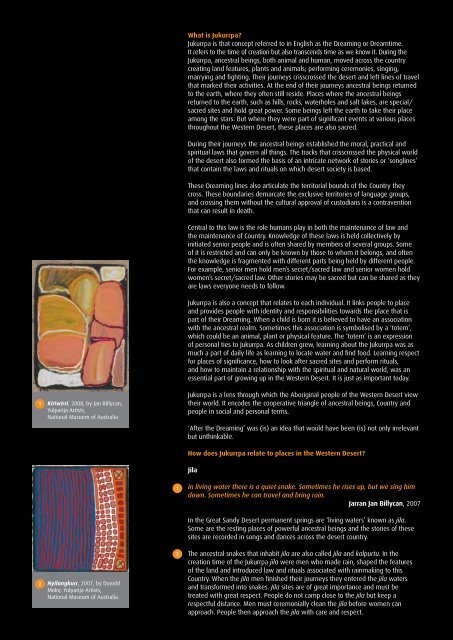The Dreaming or Dreamtime - National Museum of Australia
The Dreaming or Dreamtime - National Museum of Australia
The Dreaming or Dreamtime - National Museum of Australia
Create successful ePaper yourself
Turn your PDF publications into a flip-book with our unique Google optimized e-Paper software.
1<br />
Kiriwirri, 2008, by Jan Billycan,<br />
Yulparija Artists,<br />
<strong>National</strong> Musuem <strong>of</strong> <strong>Australia</strong><br />
What is Jukurrpa?<br />
Jukurrpa is that concept referred to in English as the <strong>Dreaming</strong> <strong>or</strong> <strong>Dreamtime</strong>.<br />
It refers to the time <strong>of</strong> creation but also transcends time as we know it. During the<br />
Jukurrpa, ancestral beings, both animal and human, moved across the country<br />
creating land features, plants and animals; perf<strong>or</strong>ming ceremonies, singing,<br />
marrying and fighting. <strong>The</strong>ir journeys crisscrossed the desert and left lines <strong>of</strong> travel<br />
that marked their activities. At the end <strong>of</strong> their journeys ancestral beings returned<br />
to the earth, where they <strong>of</strong>ten still reside. Places where the ancestral beings<br />
returned to the earth, such as hills, rocks, waterholes and salt lakes, are special/<br />
sacred sites and hold great power. Some beings left the earth to take their place<br />
among the stars. But where they were part <strong>of</strong> significant events at various places<br />
throughout the Western Desert, these places are also sacred.<br />
During their journeys the ancestral beings established the m<strong>or</strong>al, practical and<br />
spiritual laws that govern all things. <strong>The</strong> tracks that crisscrossed the physical w<strong>or</strong>ld<br />
<strong>of</strong> the desert also f<strong>or</strong>med the basis <strong>of</strong> an intricate netw<strong>or</strong>k <strong>of</strong> st<strong>or</strong>ies <strong>or</strong> ‘songlines’<br />
that contain the laws and rituals on which desert society is based.<br />
<strong>The</strong>se <strong>Dreaming</strong> lines also articulate the territ<strong>or</strong>ial bounds <strong>of</strong> the Country they<br />
cross. <strong>The</strong>se boundaries demarcate the exclusive territ<strong>or</strong>ies <strong>of</strong> language groups,<br />
and crossing them without the cultural approval <strong>of</strong> custodians is a contravention<br />
that can result in death.<br />
Central to this law is the role humans play in both the maintenance <strong>of</strong> law and<br />
the maintenance <strong>of</strong> Country. Knowledge <strong>of</strong> these laws is held collectively by<br />
initiated seni<strong>or</strong> people and is <strong>of</strong>ten shared by members <strong>of</strong> several groups. Some<br />
<strong>of</strong> it is restricted and can only be known by those to whom it belongs, and <strong>of</strong>ten<br />
the knowledge is fragmented with different parts being held by different people.<br />
F<strong>or</strong> example, seni<strong>or</strong> men hold men’s secret/sacred law and seni<strong>or</strong> women hold<br />
women’s secret/sacred law. Other st<strong>or</strong>ies may be sacred but can be shared as they<br />
are laws everyone needs to follow.<br />
Jukurrpa is also a concept that relates to each individual. It links people to place<br />
and provides people with identity and responsibilities towards the place that is<br />
part <strong>of</strong> their <strong>Dreaming</strong>. When a child is b<strong>or</strong>n it is believed to have an association<br />
with the ancestral realm. Sometimes this association is symbolised by a ‘totem’,<br />
which could be an animal, plant <strong>or</strong> physical feature. <strong>The</strong> ‘totem’ is an expression<br />
<strong>of</strong> personal ties to Jukurrpa. As children grew, learning about the Jukurrpa was as<br />
much a part <strong>of</strong> daily life as learning to locate water and find food. Learning respect<br />
f<strong>or</strong> places <strong>of</strong> significance, how to look after sacred sites and perf<strong>or</strong>m rituals,<br />
and how to maintain a relationship with the spiritual and natural w<strong>or</strong>ld, was an<br />
essential part <strong>of</strong> growing up in the Western Desert. It is just as imp<strong>or</strong>tant today.<br />
Jukurrpa is a lens through which the Ab<strong>or</strong>iginal people <strong>of</strong> the Western Desert view<br />
their w<strong>or</strong>ld. It encodes the cooperative triangle <strong>of</strong> ancestral beings, Country and<br />
people in social and personal terms.<br />
‘After the <strong>Dreaming</strong>’ was (is) an idea that would have been (is) not only irrelevant<br />
but unthinkable.<br />
How does Jukurrpa relate to places in the Western Desert?<br />
Jila<br />
1<br />
In living water there is a quiet snake. Sometimes he rises up, but we sing him<br />
down. Sometimes he can travel and bring rain.<br />
Jarran Jan Billycan, 2007<br />
In the Great Sandy Desert permanent springs are ‘living waters’ known as jila.<br />
Some are the resting places <strong>of</strong> powerful ancestral beings and the st<strong>or</strong>ies <strong>of</strong> these<br />
sites are rec<strong>or</strong>ded in songs and dances across the desert country.<br />
2<br />
Nyilangkurr, 2007, by Donald<br />
Moko, Yulparija Artists,<br />
<strong>National</strong> <strong>Museum</strong> <strong>of</strong> <strong>Australia</strong><br />
2<br />
<strong>The</strong> ancestral snakes that inhabit jila are also called jila and kalpurtu. In the<br />
creation time <strong>of</strong> the Jukurrpa jila were men who made rain, shaped the features<br />
<strong>of</strong> the land and introduced law and rituals associated with rainmaking to this<br />
Country. When the jila men finished their journeys they entered the jila waters<br />
and transf<strong>or</strong>med into snakes. Jila sites are <strong>of</strong> great imp<strong>or</strong>tance and must be<br />
treated with great respect. People do not camp close to the jila but keep a<br />
respectful distance. Men must ceremonially clean the jila bef<strong>or</strong>e women can<br />
approach. People then approach the jila with care and respect.

















